VOLVO V60 2014 Owner's Manual
Manufacturer: VOLVO, Model Year: 2014, Model line: V60, Model: VOLVO V60 2014Pages: 442, PDF Size: 13.85 MB
Page 21 of 442
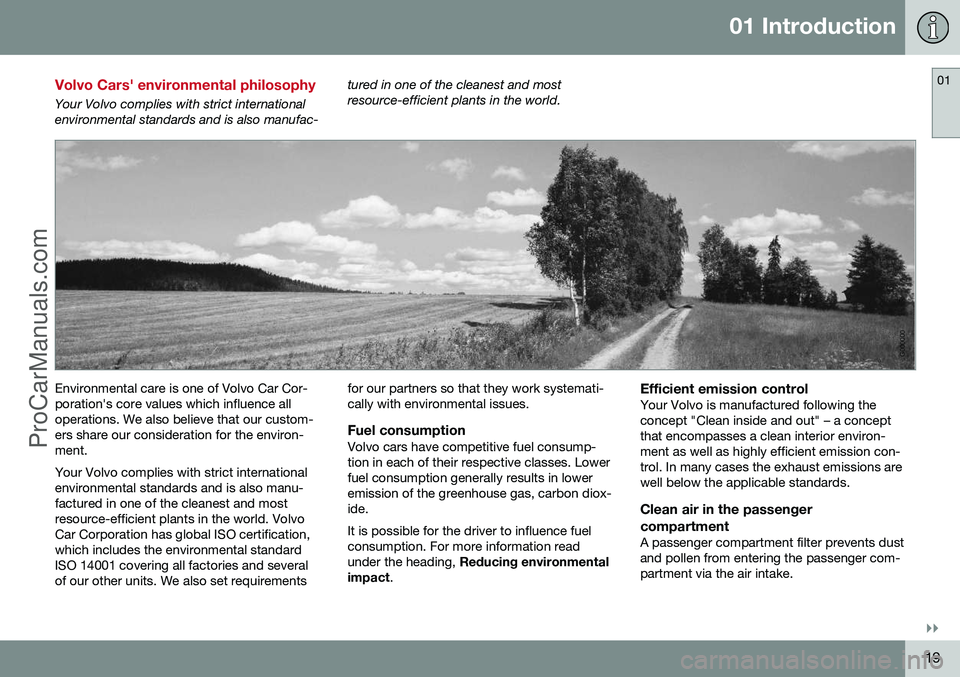
01 Introduction
01
}}
19
Volvo Cars' environmental philosophy
Your Volvo complies with strict international environmental standards and is also manufac-tured in one of the cleanest and mostresource-efficient plants in the world.
G000000
Environmental care is one of Volvo Car Cor- poration's core values which influence alloperations. We also believe that our custom-ers share our consideration for the environ-ment. Your Volvo complies with strict international environmental standards and is also manu-factured in one of the cleanest and mostresource-efficient plants in the world. VolvoCar Corporation has global ISO certification,which includes the environmental standardISO 14001 covering all factories and severalof our other units. We also set requirements for our partners so that they work systemati-cally with environmental issues.
Fuel consumptionVolvo cars have competitive fuel consump-tion in each of their respective classes. Lowerfuel consumption generally results in loweremission of the greenhouse gas, carbon diox-ide. It is possible for the driver to influence fuel consumption. For more information readunder the heading,
Reducing environmental
impact .
Efficient emission controlYour Volvo is manufactured following theconcept "Clean inside and out" – a conceptthat encompasses a clean interior environ-ment as well as highly efficient emission con-trol. In many cases the exhaust emissions arewell below the applicable standards.
Clean air in the passenger
compartment
A passenger compartment filter prevents dustand pollen from entering the passenger com-partment via the air intake.
ProCarManuals.co’
Page 22 of 442

||
01 Introduction
01
20* Option/accessory, for more information, see Introduction.
A sophisticated air quality system, IAQS* (Interior Air Quality System) ensures that theincoming air is cleaner than the air in the traf-fic outside. The system consists of an electronic sensor and a carbon filter. The incoming air is moni-tored continuously and if there is an increasein the level of certain unhealthy gases such ascarbon monoxide then the air intake isclosed. Such a situation may arise in heavytraffic, queues and tunnels for example. The entry of nitrous oxides, ground-level ozone and hydrocarbons is prevented by thecarbon filter.
InteriorThe interior of a Volvo is designed to be plea-sant and comfortable, even for people withcontact allergies and for asthma sufferers.Extreme attention has been given to choosingenvironmentally-compatible materials.
Volvo workshops and the environmentRegular maintenance creates the conditionsfor a long service life and low fuel consump-tion for your car. In this way you contribute toa cleaner environment. When Volvo's work-shops are entrusted with the service andmaintenance of your car it becomes part ofour system. Volvo makes clear demandsregarding the way in which our workshopsare designed in order to prevent spills anddischarges into the environment. Our work-shop staff have the knowledge and the tools required to guarantee good environmentalcare.
Reducing environmental impactYou can easily help reduce environmentalimpact - here are a few tips: •
Avoid letting the engine idle - switch off the engine when stationary for longerperiods. Pay attention to local regula-tions.
• Drive economically - think ahead.
• Perform service and maintenance inaccordance with the owner's manual'sinstructions - follow the intervals recom-mended in the Service and WarrantyBooklet.
• If the car is equipped with an engineblock heater*, use it before starting fromcold - it improves starting capacity andreduces wear in cold weather and theengine reaches normal operating tem-perature more quickly, which lowers con-sumption and reduces emissions.
• High speed increases consumption con-siderably due to increased wind resis-tance - a doubling of speed increaseswind resistance 4 times.
• Always dispose of environmentally hazar-dous waste, such as batteries and oils, inan environmentally safe manner. Consulta workshop in the event of uncertaintyabout how this type of waste should bediscarded - an authorised Volvo work-shop is recommended. Following this advice can save money, the planet's resources are saved, and the car'sdurability is extended. For more informationand further advice, see Eco guide (p. 63),Economical driving (p. 305) and Fuel con-sumption (p. 403).
RecyclingAs a part of Volvo's environmental work, it isimportant that the car is recycled in an envi-ronmentally sound manner. Almost all of thecar can be recycled. The last owner of the caris therefore requested to contact a dealer forreferral to a certified/approved recyclingfacility.
Related information
•
The owner's manual and the environment (p. 21)
ProCarManuals.co’
Page 23 of 442
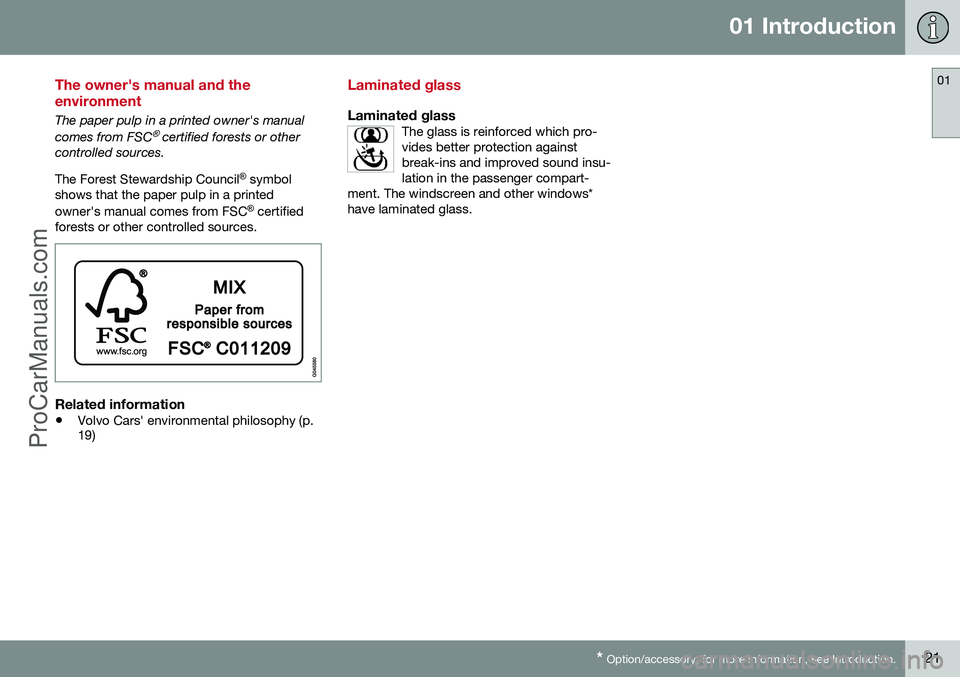
01 Introduction
01
* Option/accessory, for more information, see Introduction.21
The owner's manual and the environment
The paper pulp in a printed owner's manual comes from FSC® certified forests or other
controlled sources. The Forest Stewardship Council ®
symbol
shows that the paper pulp in a printed owner's manual comes from FSC ®
certified
forests or other controlled sources.
Related information
• Volvo Cars' environmental philosophy (p. 19)
Laminated glass
Laminated glassThe glass is reinforced which pro- vides better protection againstbreak-ins and improved sound insu-lation in the passenger compart-
ment. The windscreen and other windows*have laminated glass.
ProCarManuals.co’
Page 24 of 442
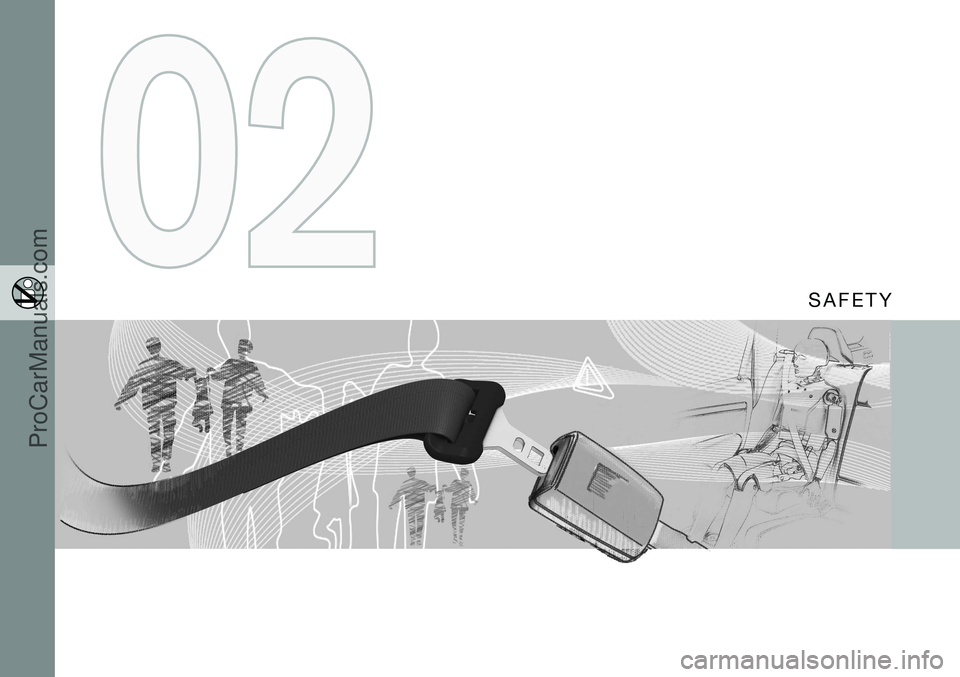
S A F E T Y
ProCarManuals.co’
Page 25 of 442
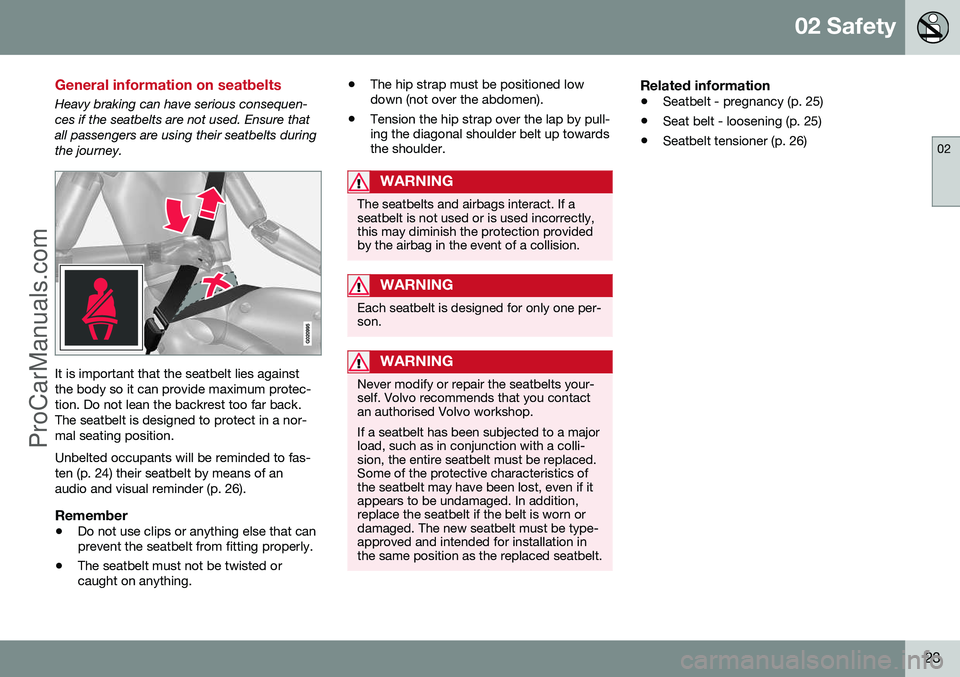
02 Safety
02
23
General information on seatbelts
Heavy braking can have serious consequen- ces if the seatbelts are not used. Ensure thatall passengers are using their seatbelts duringthe journey.
It is important that the seatbelt lies against the body so it can provide maximum protec-tion. Do not lean the backrest too far back.The seatbelt is designed to protect in a nor-mal seating position. Unbelted occupants will be reminded to fas- ten (p. 24) their seatbelt by means of anaudio and visual reminder (p. 26).
Remember
•Do not use clips or anything else that can prevent the seatbelt from fitting properly.
• The seatbelt must not be twisted orcaught on anything. •
The hip strap must be positioned lowdown (not over the abdomen).
• Tension the hip strap over the lap by pull-ing the diagonal shoulder belt up towardsthe shoulder.
WARNING
The seatbelts and airbags interact. If a seatbelt is not used or is used incorrectly,this may diminish the protection providedby the airbag in the event of a collision.
WARNING
Each seatbelt is designed for only one per- son.
WARNING
Never modify or repair the seatbelts your- self. Volvo recommends that you contactan authorised Volvo workshop. If a seatbelt has been subjected to a major load, such as in conjunction with a colli-sion, the entire seatbelt must be replaced.Some of the protective characteristics ofthe seatbelt may have been lost, even if itappears to be undamaged. In addition,replace the seatbelt if the belt is worn ordamaged. The new seatbelt must be type-approved and intended for installation inthe same position as the replaced seatbelt.
Related information
• Seatbelt - pregnancy (p. 25)
• Seat belt - loosening (p. 25)
• Seatbelt tensioner (p. 26)
ProCarManuals.co’
Page 26 of 442

02 Safety
02
24
Seatbelt - putting on
Put on the seatbelt (p. 23) before setting off. Pull the belt out slowly and secure it by pressing its locking tab into the seatbeltbuckle. A loud "click" indicates that the belthas locked.
Correctly fitted seatbelt.
Incorrectly fitted seatbelt. The belt must rest on the shoulder.
Seatbelt height adjustment. Press the button and move the belt vertically. Position the belt as highas possible without it chafing against your throat.
The buckles only fit the intended lock in the rear seat 1
.
RememberThe seatbelt locks and cannot be withdrawn: • if it is pulled out too quickly
• during braking and acceleration
• if the car leans heavily.
Related information
•Seatbelt - pregnancy (p. 25)
• Seat belt - loosening (p. 25)
• Seatbelt tensioner (p. 26)
• Seatbelt reminder (p. 26)
1
Certain markets.
ProCarManuals.co’
Page 27 of 442
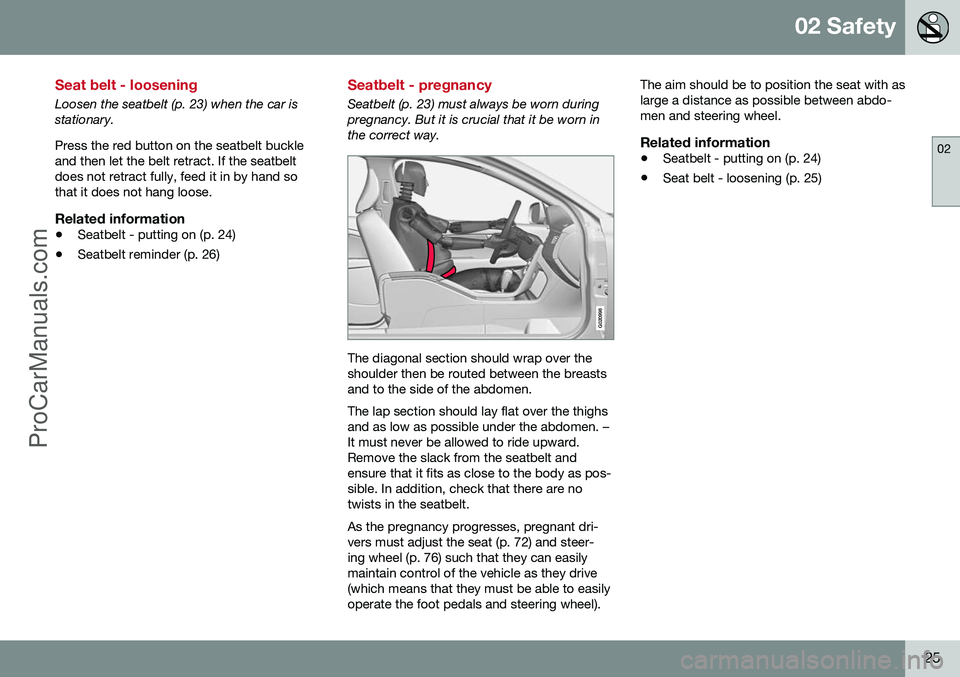
02 Safety
02
25
Seat belt - loosening
Loosen the seatbelt (p. 23) when the car is stationary. Press the red button on the seatbelt buckle and then let the belt retract. If the seatbeltdoes not retract fully, feed it in by hand sothat it does not hang loose.
Related information
•Seatbelt - putting on (p. 24)
• Seatbelt reminder (p. 26)
Seatbelt - pregnancy
Seatbelt (p. 23) must always be worn during pregnancy. But it is crucial that it be worn inthe correct way.
G020998
The diagonal section should wrap over the shoulder then be routed between the breastsand to the side of the abdomen. The lap section should lay flat over the thighs and as low as possible under the abdomen. –It must never be allowed to ride upward.Remove the slack from the seatbelt andensure that it fits as close to the body as pos-sible. In addition, check that there are notwists in the seatbelt. As the pregnancy progresses, pregnant dri- vers must adjust the seat (p. 72) and steer-ing wheel (p. 76) such that they can easilymaintain control of the vehicle as they drive(which means that they must be able to easilyoperate the foot pedals and steering wheel). The aim should be to position the seat with aslarge a distance as possible between abdo-men and steering wheel.
Related information
•
Seatbelt - putting on (p. 24)
• Seat belt - loosening (p. 25)
ProCarManuals.co’
Page 28 of 442
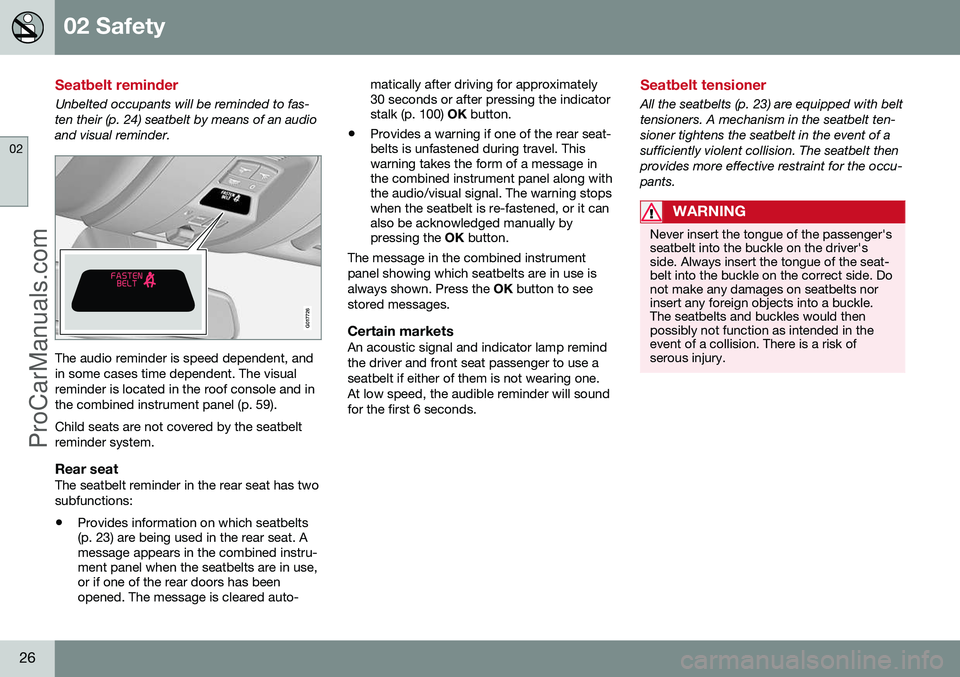
02 Safety
02
26
Seatbelt reminder
Unbelted occupants will be reminded to fas-ten their (p. 24) seatbelt by means of an audio and visual reminder.
G017726
The audio reminder is speed dependent, and in some cases time dependent. The visualreminder is located in the roof console and inthe combined instrument panel (p. 59). Child seats are not covered by the seatbelt reminder system.
Rear seatThe seatbelt reminder in the rear seat has twosubfunctions:
• Provides information on which seatbelts (p. 23) are being used in the rear seat. Amessage appears in the combined instru-ment panel when the seatbelts are in use,or if one of the rear doors has beenopened. The message is cleared auto- matically after driving for approximately30 seconds or after pressing the indicatorstalk (p. 100)
OK button.
• Provides a warning if one of the rear seat-belts is unfastened during travel. Thiswarning takes the form of a message inthe combined instrument panel along withthe audio/visual signal. The warning stopswhen the seatbelt is re-fastened, or it canalso be acknowledged manually bypressing the
OK button.
The message in the combined instrument panel showing which seatbelts are in use isalways shown. Press the OK button to see
stored messages.
Certain marketsAn acoustic signal and indicator lamp remindthe driver and front seat passenger to use aseatbelt if either of them is not wearing one.At low speed, the audible reminder will soundfor the first 6 seconds.
Seatbelt tensioner
All the seatbelts (p. 23) are equipped with belt tensioners. A mechanism in the seatbelt ten-sioner tightens the seatbelt in the event of asufficiently violent collision. The seatbelt thenprovides more effective restraint for the occu-pants.
WARNING
Never insert the tongue of the passenger's seatbelt into the buckle on the driver'sside. Always insert the tongue of the seat-belt into the buckle on the correct side. Donot make any damages on seatbelts norinsert any foreign objects into a buckle.The seatbelts and buckles would thenpossibly not function as intended in theevent of a collision. There is a risk ofserous injury.
ProCarManuals.co’
Page 29 of 442
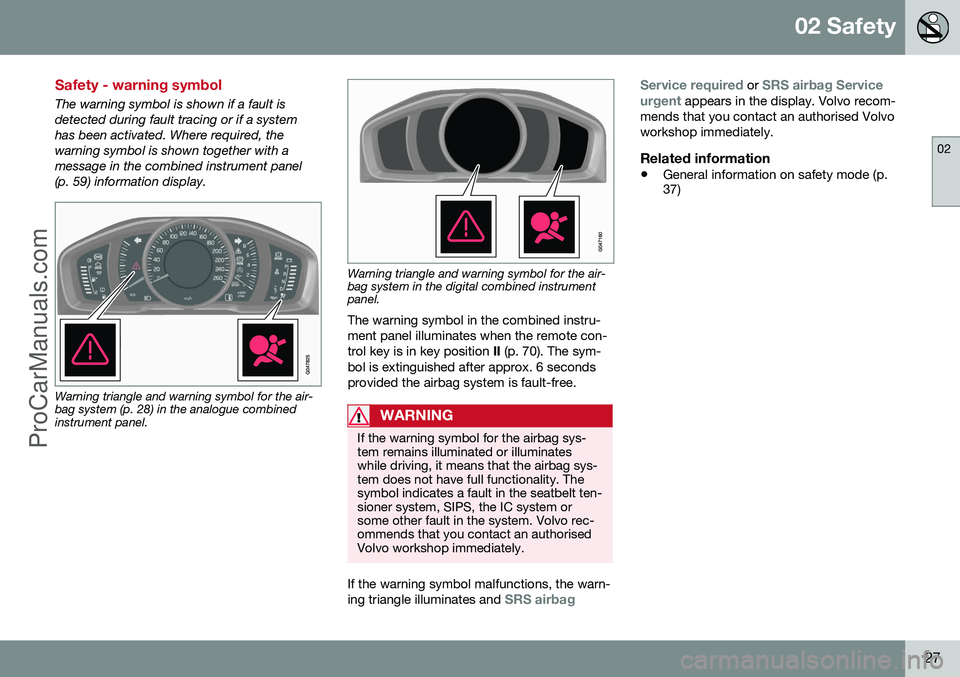
02 Safety
02
27
Safety - warning symbol
The warning symbol is shown if a fault is detected during fault tracing or if a systemhas been activated. Where required, thewarning symbol is shown together with a
message in the combined instrument panel
(p. 59) information display.
Warning triangle and warning symbol for the air- bag system (p. 28) in the analogue combinedinstrument panel.
Warning triangle and warning symbol for the air- bag system in the digital combined instrumentpanel.
The warning symbol in the combined instru- ment panel illuminates when the remote con-trol key is in key position II (p. 70). The sym-
bol is extinguished after approx. 6 secondsprovided the airbag system is fault-free.
WARNING
If the warning symbol for the airbag sys- tem remains illuminated or illuminateswhile driving, it means that the airbag sys-tem does not have full functionality. Thesymbol indicates a fault in the seatbelt ten-sioner system, SIPS, the IC system orsome other fault in the system. Volvo rec-ommends that you contact an authorisedVolvo workshop immediately.
If the warning symbol malfunctions, the warn- ing triangle illuminates and SRS airbag Service required
or SRS airbag Service
urgent appears in the display. Volvo recom-
mends that you contact an authorised Volvo workshop immediately.
Related information
• General information on safety mode (p. 37)
ProCarManuals.co’
Page 30 of 442
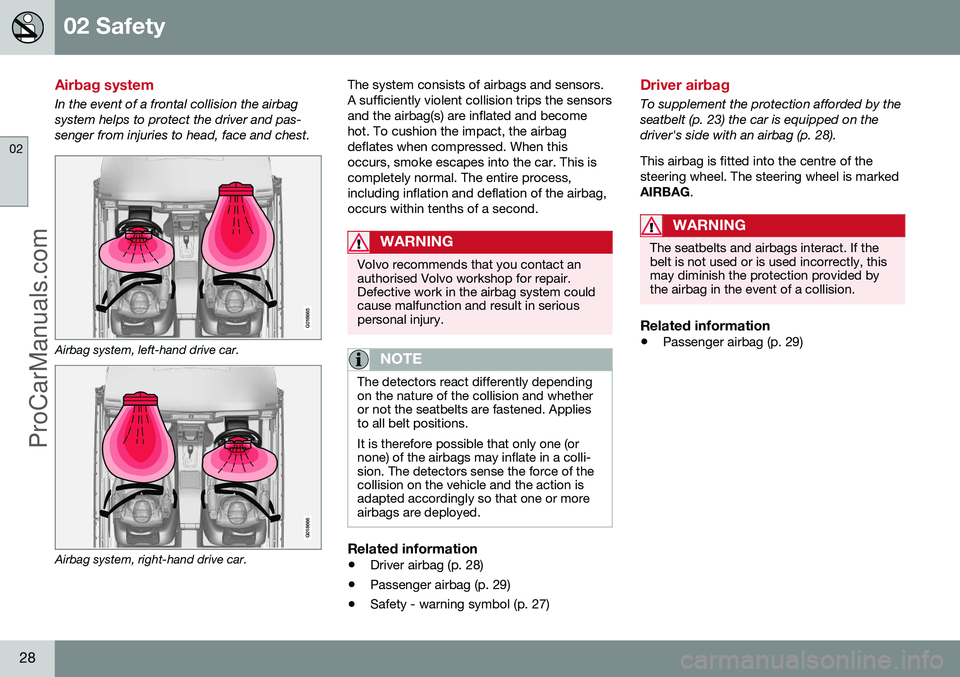
02 Safety
02
28
Airbag system
In the event of a frontal collision the airbag system helps to protect the driver and pas-senger from injuries to head, face and chest.
G018665
Airbag system, left-hand drive car.
G018666
Airbag system, right-hand drive car.The system consists of airbags and sensors. A sufficiently violent collision trips the sensorsand the airbag(s) are inflated and becomehot. To cushion the impact, the airbagdeflates when compressed. When thisoccurs, smoke escapes into the car. This iscompletely normal. The entire process,including inflation and deflation of the airbag,occurs within tenths of a second.
WARNING
Volvo recommends that you contact an authorised Volvo workshop for repair.Defective work in the airbag system couldcause malfunction and result in seriouspersonal injury.
NOTE
The detectors react differently depending on the nature of the collision and whetheror not the seatbelts are fastened. Appliesto all belt positions. It is therefore possible that only one (or none) of the airbags may inflate in a colli-sion. The detectors sense the force of thecollision on the vehicle and the action isadapted accordingly so that one or moreairbags are deployed.
Related information
•
Driver airbag (p. 28)
• Passenger airbag (p. 29)
• Safety - warning symbol (p. 27)
Driver airbag
To supplement the protection afforded by the seatbelt (p. 23) the car is equipped on thedriver's side with an airbag (p. 28). This airbag is fitted into the centre of the steering wheel. The steering wheel is markedAIRBAG
.
WARNING
The seatbelts and airbags interact. If the belt is not used or is used incorrectly, thismay diminish the protection provided bythe airbag in the event of a collision.
Related information
•Passenger airbag (p. 29)
ProCarManuals.co’